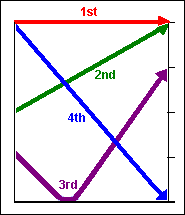|
Pinyin
Chinese Pinyin is the romanization of the Chinese "written
sound". Romanization approximates Mandarin pronunciation with
Western spellings and includes a tone mark to signify the
pitch of a word. Just like alphabet A - Z to
English, Pinyin provides a phonetic alphabet for Chinese and
is taught from Grade 1 in Chinese elementary schools. It is a
fundamental tool used for learning the spelling of Chinese
characters throughout Chinese language study.
Pinyin is used by most modern Chinese
dictionaries to denote pronunciation of characters. It is also
an efficient input method in Chinese computer software, which
is natively supported by Microsoft Windows OS.
After mastering Pinyin, you can easily read Chinese books with
Pinyin marked, learn Chinese characters by looking in the
dictionary, or input Chinese characters into your computer, it
will take your Chinese study to a higher level.
25 out of 26 English alphabet letters are used in Pinyin.
Letter 'v' is not used, while letter ' ü' is added to
represent the vowel sound of 'yu'.
Pinyin
includes consonants and vowel letters. 1. Consonant
letters There are 20 consonant letters
use in Mandarin (three consonants are represented by
combinations of two letters - 'zh', 'ch' and 'sh'), they are:
b, p, m, f, d, t, n, l, g, k, h, j, q, x, z, c, s, zh, ch, sh,
r, y, w 2. Vowel letters
There are 6 vowel letters used in Mandarin:
a, o, e, i, u, ü 3. Syllables
Syllables are composed by consonants, vowels and tone.
The consonant that begins a syllable is an Initial, they can
be: b, p, m, f, d, t, n, l, g, k, h, j, q,
x, z, c, s, zh, ch, sh, r, y, w The rest
after the initial are finals. A Final can be a single vowel, a
combination of vowels, or combination of vowels and nasals 'n'
or 'ng': There are 6 simple finals which are
single vowels, they are: a, o, e, i, u, ü.
The others are compound finals, they are:
ai, ao, ou, ei, ia, ie, iao, iou, ua, uo, uai, uei, üe, an,
ang, ong, en, eng, in, ing, ian, iang, iong, uen, ueng, uan,
uang, ün, üan
The combination of 21 initials
and 33 finals in Mandarin romanization (there are five more
finals, but they share the same symbols as other finals) form
about 420 different sounds. A word
pronunciation consists of initial and final with its tone. In
some cases, the initial can be omitted.
Although most of the sounds are generally close to how they
are used and pronounced in English, some don't follow English
letters exactly and are pronounced differently.
Pay extra attention to the differences and listen closely to
each Chinese sound, it takes practices to pronounce correctly.
The Tones of Mandarin Chinese
"Chinese is a tonal language." This sentence
has confounded millions of you, no doubt. To clarify, we don't
mean that pronouncing the same word, or character, in
different tones affects its meaning. Instead, we mean that the
tone for each Chinese character is, for lack of a better word,
assigned. Mandarin has four tones - five if
you count the "neutral" tone - and as you'll see below,
pronouncing the tone just right is very important.

Written characters don't reveal their initials and finals, nor
do they indicate which tones they are to be pronounced in.
Tones also have nothing to do with parts of
speech or any other variable. Each character's "assigned" tone
is simply learned when you study or "acquire" Chinese.
The four tones are usually depicted graphically with the
accompanying chart, to show "where" each one occurs in tonal
space. The following table illustrates tone
markings above the sound ma and describes how each tone is
vocalized:
Here are a couple points to keep in mind as
you soak in the table just above: The four
tone markings used in Pinyin were borrowed from the Yale
system. The Wade-Giles system places a 1, 2, 3, or 4 after
each syllable to indicate its tone. And this is very
important: If you use the wrong tones, your listeners may not
be able to understand you. Those of us who studied Chinese in
Chinese-speaking regions remember quite well the frustration
of not being understood early on simply because our tones were
a little off. EXAMPLE
Everyone seems to know this one: Yes, just by saying
"ma" in different tones, you can ask, "Did mother scold the
horse?"
妈妈骂马吗?
(mā mā mà mă ma?)
Tones: essential to meaning
In spoken Mandarin Chinese, a word has one of four tones, or
inflections. The tone distinguishes the word from other
similar-sounding words (homonyms). When a Chinese word is
written in the Roman alphabet (such as in pinyin, the official
romanization system in the PRC), the tone is indicated either
with an accent mark (diacritical mark) or with a numeral, 1 -
4.
And context has a big role... In
spoken Chinese, in addition to a word's tone, context plays a
large part in conveying meaning. While context serves the same
purpose in English (think of "bat," or "do, dew, due"), there
are many fewer problem cases because English has fewer
monosyllable words, while Chinese is a monosyllabic language.
There are not enough single-syllable sounds to have a rich
vocabulary without repeated use of some. In fact, many must be
reused, even in the same tone, making context very important
in conveying meaning in spoken Chinese. In one medium-sized
Chinese-English dictionary, I find six words pronounced da
(first tone), seven pronounced da2, one pronounced da3, and
one pronounced da4. In written Chinese (characters), the
problems are reduced since, although some Chinese characters
do stand for more than one word, most stands for only a single
word.
|

